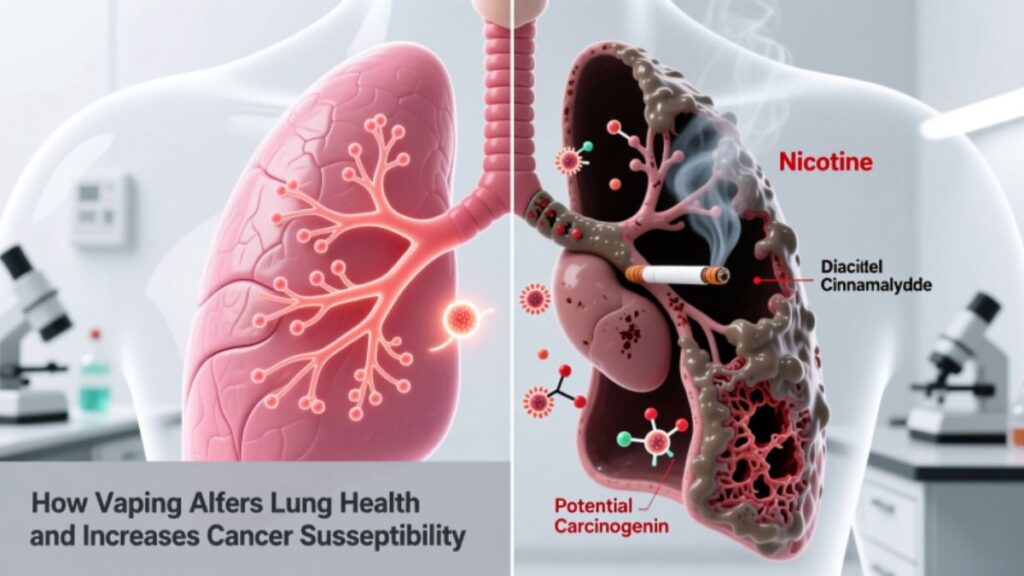Key Takeaways
- Vaping introduces harmful chemicals into the lungs, leading to tissue damage and inflammation.
- Long-term e-cigarette use is linked to increased risk of chronic respiratory diseases.
- Dual use of cigarettes and e-cigarettes significantly amplifies lung cancer risk compared to smoking alone.
- Nicotine and other e-liquid ingredients promote biological changes associated with cancer development.
- Public health efforts should focus on educating about the true risks of vaping to prevent increased disease burden.
Introduction
Vaping’s reputation as a less harmful alternative to traditional cigarette smoking has spurred its use, especially among younger generations. With the sleek designs of e-cigarettes and an array of enticing flavors, these products have rapidly attracted not only those trying to quit smoking but also new users who may never have smoked before. However, over the past decade, researchers have begun to uncover a different side of the vaping story, one that highlights significant risks for lung health and cancer susceptibility. Mounting evidence suggests the true impact of vaping on the body is much deeper and more damaging than initial marketing campaigns claimed. For those wondering, does vaping cause lung cancer? Recent scientific evidence provides growing reasons for concern about the safety of these devices. Despite being marketed as a safer option, e-cigarettes deliver a cocktail of chemicals directly to the lungs. This exposure irritates the airways and may set off inflammatory and cellular processes that heighten susceptibility to various lung diseases—and potentially malignancies—over time. Understanding exactly how vaping interacts with lung tissues and affects disease risk is essential for anyone considering using e-cigarettes or supporting public health recommendations.
Understanding Vaping and Its Components
E-cigarettes operate by heating a liquid—commonly called e-liquid or vape juice—that contains nicotine, flavoring agents, propylene glycol, and vegetable glycerin. Once heated, this mixture forms a fine aerosol that users inhale deeply into their lungs. Contrary to the idea that vaping only produces “harmless water vapor,” scientific analysis has shown that the resulting aerosol contains a complex mix of substances, many of which are recognized by toxicologists as harmful or even carcinogenic. For instance, e-cigarette aerosols can contain volatile organic compounds (VOCs), heavy metals from device heating elements, and small particles capable of lodging in lung tissue. Even some of the agents used solely for flavor, such as diacetyl and cinnamaldehyde, have been connected to specific lung injuries when inhaled. The rise in availability of thousands of flavors—with names suggesting safety or health benefits—further muddies the waters. While many chemicals used as flavorings are considered safe when eaten, their effects when inhaled repeatedly and over prolonged periods are poorly understood and are increasingly linked to respiratory harm. Furthermore, the popularity of disposable vape devices and customizable mods has made it even easier for users to access high-risk products without fully understanding their contents.
Impact on Lung Tissue
Recent research, including studies funded by the National Heart, Lung, and Blood Institute (NHLBI), reveals that inhalation of e-cigarette aerosols can produce significant damage to delicate lung tissues. When chemicals from flavored e-liquids enter the lungs, they trigger inflammatory responses. The epithelial cells that line the respiratory system act as a first line of defense, but repeated exposure to irritants in vape aerosols gradually weakens and damages these cells. In practical terms, this damage compromises the lungs’ natural barriers, rendering individuals more vulnerable to invasion by bacteria, viruses, and environmental toxins. As a consequence, acute lung injuries have increased among vapers, with some cases developing into a condition known as EVALI (E-cigarette or Vaping product use-Associated Lung Injury), characterized by symptoms such as coughing, chest pain, shortness of breath, and fever. EVALI can be severe and occasionally fatal, especially in otherwise healthy young adults. Population studies and case reports have underscored these risks, documenting hundreds of hospitalizations and deaths and showing the real, life-altering potential for harm (CDC: Outbreak of Lung Injury Associated with Vaping). Even those who never experience acute injury face the prospect of cumulative, long-term damage to their lung tissues over years of exposure.
Increased Risk of Respiratory Diseases
Beyond short-term tissue damage, regular e-cigarette use is now strongly associated with chronic respiratory conditions. Long-term inhalation of e-cigarette aerosols is connected with increased risk for developing persistent conditions like asthma, chronic bronchitis, and even emphysema. These diseases are accompanied by persistent cough, wheezing, and shortness of breath, which often worsen over time and significantly impair quality of life. A major study published in JAMA Network Open provided clear evidence that adults who reported using e-cigarettes daily had higher rates of these respiratory symptoms—and the risk was most striking among individuals who initiated use before the age of 25. Indeed, the adolescent and young adult population is uniquely susceptible: lungs and immune systems are still developing, and the addictiveness of nicotine makes breaking the habit more difficult. Early and sustained exposure to e-cigarette aerosols may lay the foundation for chronic respiratory illnesses that emerge later in life (JAMA Network Open: E-Cigarette Use and Respiratory Disease).
Vaping and Cancer Susceptibility
Increasing scientific scrutiny has identified a troubling potential for vaping to elevate cancer risk. This risk becomes especially pronounced among “dual users”—individuals who both vape and smoke traditional cigarettes. Research indicates that these dual users have an up to fourfold increase in the likelihood of developing lung cancer compared to those who only smoke. The reason relates to the ways vaping compounds tobacco’s risks: rather than substituting one harm for another, it amplifies total toxic exposure with more sources of carcinogens. Carcinogenic compounds such as formaldehyde and acrolein, which are found in some e-liquids and their byproducts, cause direct damage to cellular DNA. This genetic harm, when combined with other alterations in the cell environment, can kickstart the development of cancer. Notably, the absence of tobacco combustion in e-cigarettes does not guarantee safety; the process of aerosol generation itself can create new harmful compounds capable of inducing cancerous changes in lung cells.
Biological Mechanisms at Play
Nicotine remains the most thoroughly studied toxic component in e-cigarettes, but it is far from the only culprit in increasing cancer susceptibility. In lung tissue, nicotine promotes several cellular changes associated with cancer progression. It encourages rapid cell division, aids in the growth of new blood vessels (allowing tumors to feed and grow), and changes how cells move and stick together in the body. One particularly concerning effect is the induction of a biological process called epithelial–mesenchymal transition (EMT). During EMT, normal lung cells lose their protective characteristics and acquire features that allow them to invade surrounding tissues, evade immune detection, and even resist the effects of chemotherapy—all factors that accelerate cancer progression (National Cancer Institute: Vaping and Cancer Risk). Researchers are also finding that some flavoring chemicals, once inhaled, might play supporting roles in these malignant transformations. Certain aldehydes and other chemicals can alter the genetic and protein landscape inside lung cells, further amplifying the risk of developing cancer.
Public Health Implications
The explosion in vaping among young people raises alarm bells for public health experts, who worry that hard-earned progress in reducing youth smoking rates could be undone. Misunderstandings about the safety profile and addictiveness of e-cigarettes of all types are widespread, leading to higher experimentation and adoption rates among middle and high school students. The rapid normalization of vaping culture risks binding a new generation to lifelong addiction and, potentially, preventable diseases. To confront these challenges, public health organizations emphasize the need for better public education, stronger labeling and marketing regulations, and more rigorous science to keep pace with evolving products. Preventive efforts now must address not only traditional tobacco but also the potential dangers—sometimes hidden—of e-cigarettes. Without swift action to improve awareness and regulation, the burden of respiratory disease and cancer associated with nicotine and vaping could continue to grow, eroding decades of public health advancement.
Final Thoughts
E-cigarettes, often pitched as a “safer” option, are far from benign. Mounting evidence clearly links vaping to both acute lung injury and chronic respiratory disease, while also suggesting a strong relationship with heightened cancer susceptibility. The risks are compounded in those who use both traditional and electronic cigarettes, and the popularity of vaping among youth makes public health intervention urgent. Greater awareness backed by robust public health initiatives is essential to correct misconceptions and protect communities from long-term harm.







